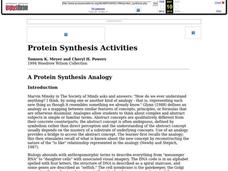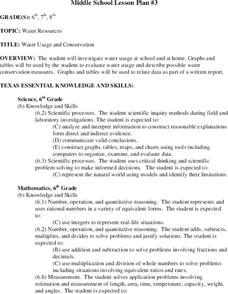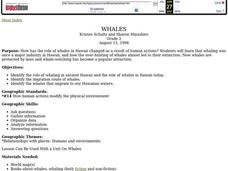Curated OER
Simple Machines
Third graders examine and identify the six types of simple machines. Using a model of each simple machine, they demonstrate the state the function of them to the class. They discover examples of simple machines at school and home and...
Curated OER
Protein Synthesis Activities
Students compare the process of protein synthesis in an analogy. They simulate the process of protein synthesis kinesthetically using index cards and write a paragraph to explain the process.
Curated OER
Can You Find a Solution?
Learners explore the topic of public conservation. In this Florida panthers lesson, students read a scenario about the endangered panther and collaborate to plan a way to protect the panther population. Learners also participate in a...
Curated OER
Night of the Twister
Pupils use reading strategies for Night of the Twister. In this reading strategies lesson, students name five major catastrophes and books about each. Pupils complete a vocabulary section, make inferences and predictions, read the story...
Curated OER
Solar Box Cooker
Learners explore solar power. In this solar power lesson plan, students build simple solar cookers after they study convection, conduction, and radiation. Learners transfer their knowledge of how the solar cooker works to climate changes...
Curated OER
A Model of Earth's Tectonic Plates
Students build a model of the Earth showing tectonic plate boundaries. The pattern for the model is provided in the instructional activity. This is a very useful hands-on component for a instructional activity about geology or earthquakes.
Curated OER
Inventing and Presenting Unit 3: Persuasive Speaking and Invention Promotion
Young scholars write a proposal for a speech. Students prepare appropriate visuals for use in the proposed speech. Young scholars produce one or more graphs that summarize the results from the experimentation. Students deliver an...
Curated OER
Everyone Knows It's Windy
Students create an anemometer, an instrument that measures wind speed.
Curated OER
Sea Connections
Young scholars, after locating different marine habitats on a globe, play a card game about ecosystems, food webs and organisms.
Curated OER
Water Usage and Conservation
Students investigate water usage at school and at home. They use graphs and tables to evaluate water usage. Students describe possible water conservation measures. They use graphs and tables to relate data as part of a written report.
Curated OER
Pond Water
Students explore a creek environment. They make observations, identify the living and nonliving factors in the environment and collect a plankton sample to take back to the classroom. In addition, they look at plankton under a microscope.
Curated OER
What's Matter?
Students explore the definition of matter. In exploring matter lesson students get into groups and navigate the Internet to answer questions.
Curated OER
It Bears Repeating!!!
Students research bears and their characteristics with a specific study on North American bears and polar bears. In this bear study lesson, students read books about polar bears and wild bears. Students complete activities to further...
Curated OER
Introducing Biodiversity
Learners investigate biodiversity by creating reports with their classmates. In this ecosystem lesson, students utilize the Internet to research the different types of life in our environment and different locations around the...
Curated OER
Whales
Second graders identify the role of whaling in ancient Hawaii and the role of whales in Hawaii today, identify the migration route of whales and identify the whales that migrate to our Hawaiian waters.
Curated OER
Fun Photosynthesis
Second graders, using large colored poster board, explore photosynthesis and its effect on the food chain and survival of organisms.
Curated OER
Garbage/Solid Waste Disposal
Students examine the problem of solid waste disposal in modern society. They decide on a site for waste disposal. They investigate the many different types of waste that need to be dealt with. They participate in three learning station...
Curated OER
How Can We Keep Our Forests Intact and Have Our Chocolate Too?
Fourth graders explore various methods of growing and harvesting rainforest foods in order to sustain its biodiversity. They discuss the various uses for trees from several viewpoints. Students research chocolate demand and land use...
Curated OER
Wildlife on the African Savanna
Second graders discuss African Savanna, choose and illustrate example of wildlife that is found in the Savanna, and write paragraph describing wildlife they chose to draw.
Curated OER
Environmental Fair for our St. Mary¿¿¿s River
Students list sources of pollution and their effects on the St. Mary River environment. They discuss how pollution may effect the environment and draw up a list of possible types of pollution.
Curated OER
Endangered Ecosystems Grades 4-5
Young scholars read about research at the field sites. They read field reports from team members at the site. Students conduct their own research on ecosystems in their lives. They explore and build an interactive food web. Young...
Curated OER
Where in the World is Rubber?
Students examine rubber. In this natural rubber lesson students identify a naturally producing rubber location and present a detailed description of a rubber producing country.
Curated OER
Lesson Design Archaeology
Students participate in their own excavation and measure and record as they go. In this archaeology instructional activity students divide into groups and solve the mystery of what they uncovered in their dig box.
Curated OER
Ecuadorian Rainforest: If the Forests Could Talk
Third graders explore the delicate balance the must be maintained in a rainforest ecosystem. In this ecosystems lesson, 3rd graders learn about the importance of "little things" such as bugs or a certain plant in the rainforest. This...























